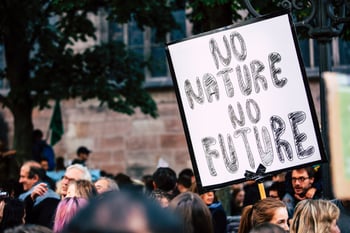
Climate change, if you haven’t heard, is real1.
As advertisers and brands, it falls on us to do what we can to tell the story of a realistic, more sustainable future. We have a duty to do so responsibly and in a way that not only resonates, but drives people to actually change. And yet, one major hurdle still stands in the way: the continued political polarization of the topic.
Responsible advertising related to climate change must break through this polarization to reach a wide audience, make sustainability a priority for brands, and continue to shift public opinion.
Here’s the good news: Climate change affects everyone, and from white collar to blue, red voters and green ones, everyone is interested in action. Here are some ways we can move past the political polarization of climate change and make genuine strides toward effective climate action, as brands and advertisers.
Right off the bat, it’s important to keep the following in mind: brands don’t have to be radical in order to make sustainable improvements that are worth marketing. Big or small, any action toward helping save the planet and our future is worthwhile.
Focus on the Personal and Local Effects
Oddly enough, when it comes to messaging, the big picture matters less than the individual one. Whether an American believes in climate change or not, they are currently feeling its effects on their lives. We all see more dangerous weather patterns, droughts, and flooding happening with our own eyes. Especially in our communities, the human stories of those who are helping others and doing what’s right when it comes to fighting climate change are more powerful than ever. This includes brands.
How should we talk about climate change? For messaging to resonate it has to feel local and personal. One way to get over the polarization hump is to focus on pain points that we all, as human beings, are concerned with: the health and safety of our families, economic opportunities, the resilience and comfort of our homes and communities. Focus on what unites us, not divides us — and don’t be afraid of the facts.
There’s an element of doing what’s right, and an element of savviness to this approach. Brands that help close the political gap to drive action are critical to the fight for a more sustainable future for all. As an added value, brands that speak up now have the opportunity to authentically position themselves as proactive and solutions-focused in more ways than one.
Spending habits are changing, too: A 2021 study by Business Wire showed that globally, sustainability was rated as an important purchase criteria for 60% of consumers. That majority alone shows that sidestepping politics to deliver un-polarized messaging on climate change is a good idea. Beliefs about climate change are changing; lead the way and show that climate change doesn’t have to be about politics, but rather treating the planet (and each other) better.
What does marketing about sustainability, without polarization, look like? Here are three quick examples.
Dell: The tech brand has dived into clean energy by announcing plans to use solar energy to power their plants, reducing emissions. They also plan to boost recycling to reduce tech waste significantly by 2030. Marketing this directly could turn off some customers. Instead, they focus on benefits to customers who want to help: Any Dell customer can return their equipment for free to Dell, who promises to take care of recycling and destroying the waste sustainably. In short: Give consumers who care the opportunity to buy in.
Dawn: Dawn dish soap does a great job marketing their sustainability success stories. Remember, any action helps, big or small: They use up to 35% post consumer recycled plastic in their bottles. It’s not a huge win, but it helps. And when paired with their promotion of Dawn’s use to clean birds and wildlife harmed by oil slicks, they have a simple, effective message.
Beyond Meat: “You’ve evolved. So should your snacks,” says Beyond Meat’s latest commercials for Beyond Meat jerky. The ad’s not about saving animals or even the planet; it’s about growing up and eating better and healthier. Again, the focus is on the individual, not the big picture or the system. The sustainability part isn’t even a pitch, but rather a simple fact: “10 grams of plant-based protein.” Who can argue with that?
Recognize that attitudes are changing, fast
In a 2019 Pew study, 67% of all American adults said the US government wasn’t doing enough to protect the climate. 90% of Democrats and nearly 40% of Republicans said the government wasn’t doing enough about it. This is a reversal of trends in the 2000s when there was an increase in skepticism about climate change.
It appears that repeated messages about the danger of messing with the climate are sticking with Americans. (This is a notable success, given our attention paid to “apocalypse fatigue.”) Perhaps most importantly, studies show that younger generations are especially interested in addressing climate change issues. Want to stay ahead of the game? Look to Gen Z.
Politicians are responding in kind. Take, for instance, an increase in Republican members of the house and Senate who are admitting climate change is human-driven — or better yet, the passage of the Inflation Reduction Act, which pledged $370 billion toward low-emission energy to fight climate change. It was the largest bill ever, by far, of its kind. And for Americans who care about climate change — that is, most of us — it signaled a ray of hope, and a future for clean energy.
Steering Clear of a Powerful Topic?
Brands and advertisers still tend to steer away from talking about climate change because it’s divisive politically. And it’s true that we haven’t heard too many additional success stories from brands who are proactively taking the issue on, outside of Patagonia and a few others. It appears that plenty of brands are taking some action toward sustainability and climate justice — but they aren’t talking about it.
Yet our current position as human beings facing gargantuan climate change catastrophe has all the makings of engaging and productive storytelling.
It’s an exciting time to be alive, though it sometimes feels like a rollercoaster ride between hope and sadness. We are generations of humans that matter; how fast we embrace clean energy, and how quickly we can remove greenhouse gasses from the atmosphere, matters. Not just to one or two of us, but to all of us. And whether it’s advertising for high-efficiency heat pumps in individual homes or for international aid organizations, the uncertain future facing mankind can be both engaging and hopeful.
How brands make the most of that hope - to do the most good for the greatest number of people from all walks of life and backgrounds - is the single most exciting and potentially life-changing challenge yet.
1 IPCC, 2018: Summary for Policymakers. In: Global Warming of 1.5°C. An IPCC Special Report on the impacts of global warming of 1.5°C above pre-industrial levels and related global greenhouse gas emission pathways, in the context of strengthening the global response to the threat of climate change, sustainable development, and efforts to eradicate poverty [Masson-Delmotte, V., P. Zhai, H.-O. Pörtner, D. Roberts, J. Skea, P.R. Shukla, A. Pirani, W. Moufouma-Okia, C. Péan, R. Pidcock, S. Connors, J.B.R. Matthews, Y. Chen, X. Zhou, M.I. Gomis, E. Lonnoy, T. Maycock, M. Tignor, and T. Waterfield (eds.)]. World Meteorological Organization, Geneva, Switzerland, 32 pp
